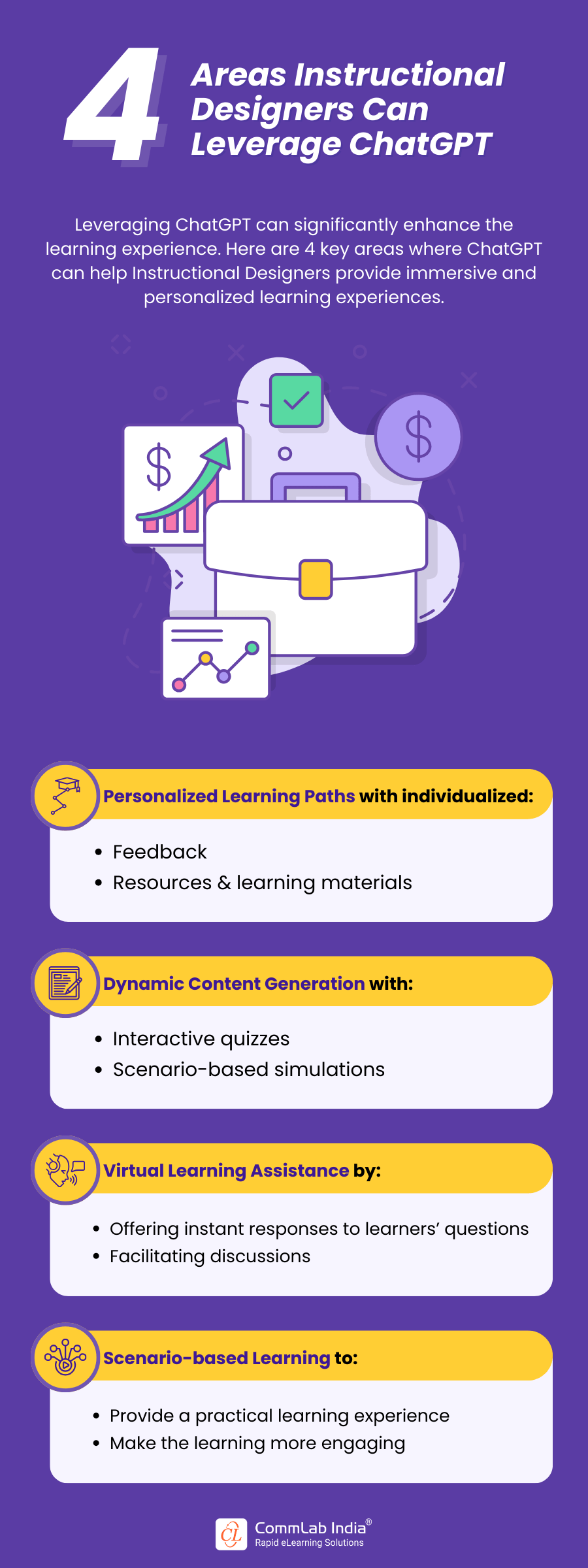ChatGPT’s Transformative Impact on Instructional Design [Infographic]
![ChatGPT’s Transformative Impact on Instructional Design [Infographic] ChatGPT’s Transformative Impact on Instructional Design [Infographic]](https://blog.commlabindia.com/hubfs/blogs/instructional-design-chatgpt-use-info.jpg)
AI is revolutionizing instructional design by introducing advanced capabilities that enhance the learning experience. One notable impact is the ability to create personalized learning paths through AI algorithms that understand all learner data. This customization ensures that content aligns with learners' specific needs and adapts to their unique learning styles. Additionally, AI simplifies the content creation process, automating routine tasks and allowing instructional designers to focus on strategic aspects of course development. With adaptive learning systems, natural language processing, and data-driven insights, AI is not just a tool but a transformative force, shaping the future of instructional design to be more advanced, tailored, and responsive to the evolving needs of learners in the digital age.
Innovation in Instructional Design with ChatGPT
The integration of cutting-edge technologies has brought about significant advancements, and among these, ChatGPT stands out as a powerful ally for instructional designers. Developed by OpenAI, ChatGPT is an artificial intelligence language model that opens new avenues for creativity and efficiency in the instructional design process. With its ability to generate human-like text and provide instant responses, ChatGPT serves as a valuable tool for brainstorming ideas, refining language in instructional materials, and offering insights for creative content development. ChatGPT emerges as a futuristic companion, enhancing collaboration and sparking innovative approaches in the creation of engaging and effective learning experiences.
Here's an insightful infographic highlighting the areas where ChatGPT can be leveraged by instructional designers.
→ Download Now: Redefining Generative AI for Dynamic L&D Teams [eBook]
Tips For Instructional Designers to Work with ChatGPT
1. Define Clear Objectives
Clearly outline the learning objectives you want to achieve with ChatGPT's assistance. Whether it's brainstorming ideas, refining language, or generating content outlines, having a clear vision will maximize the tool's effectiveness.
2. Provide Specific Input
Give ChatGPT detailed and specific input to get more relevant and targeted responses. Clearly articulate your requirements to receive insights that align closely with your instructional design needs.
3. Iterate and Refine
Use ChatGPT's responses as a starting point and iterate on the generated content. Refinement is key to ensuring that the output aligns perfectly with your instructional goals and maintains a consistent tone.
4. Verify Information
If ChatGPT provides information, especially in research-heavy topics, cross-verify it for accuracy. While ChatGPT is a powerful tool, human verification is essential to maintain the integrity of instructional content for corporate training.
5. Experiment with Prompts
Try out different prompts to see how ChatGPT responds. Adjust your prompts based on the type of assistance you need.
6. Stay Mindful of Context
Be mindful of the context in which you're using ChatGPT. Understand its strengths and limitations and adapt your use accordingly. Context-awareness ensures more effective collaboration with the tool.
Wrapping it up!
With ChatGPT’s use in instructional design, the potential for creativity, efficiency, and transformative learning experiences becomes evident. Leveraging the collaborative power of AI in instructional design opens new opportunities for innovation. To delve deeper into the realm of generative AI and its applications in training, consider downloading our comprehensive eBook. Explore the strategies that await in instructional design. Download our eBook now!






![4 Things You Need to Know to Be a Successful Instructional Designer [Infographic]](https://blog.commlabindia.com/hubfs/Imported_Blog_Media/instructional-design-strategies-for-intensive-learning-infographic.jpg)
